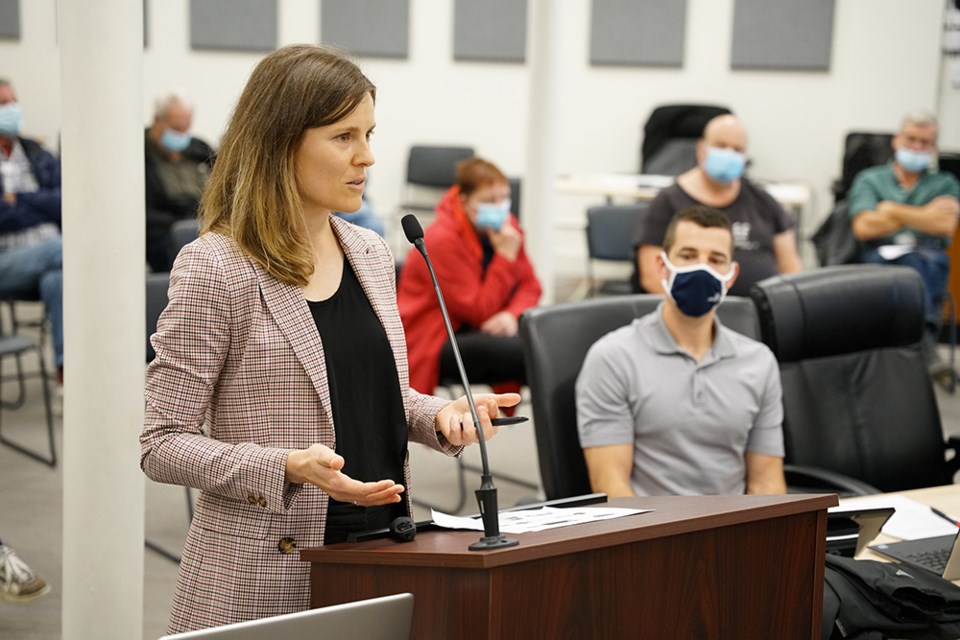City of Powell River council will consider adopting a bicycle network strategy and directing staff to prepare amendments to the city’s sustainable official community plan bylaw.
City sustainability planner Ana Lukyanova, at the October 5 committee of the whole meeting, outlined the strategy, which grew from a $10,000 active transportation planning grant from Union of British Columbia Municipalities (UBCM) to support the development of the bicycle network strategy. According to Lukyanova, UBCM subsequently increased the grant amount to $20,000, which allowed the city to engage a consulting firm to develop the city’s first all ages and abilities (AAA) bicycle network plan.
Lukyanova told councillors she was presenting the completed bicycle network strategy document. She said what prompted the development of the network plan was in 2019, the province came out with a new active transportation design guide.
“This document set a really new standard for the quality of pedestrian and cycling infrastructure in the province,” said Lukyanova. “At the centre of this new design guide is an all ages and abilities approach. It’s this idea that active transportation infrastructure must be comfortable for people of all ages, independent of their physical ability.
“This provincial design guide also supports the provincial goal of zero serious injury or fatality on our streets.”
Lukyanova said typically, with AAA infrastructure, if it’s a busy street, it implies physical separation from traffic, creating safety and making it accessible to all ages. She said it could also involve a completed off-street facility where there is no interaction with vehicles. It can also be a local street bikeway, so if it is a traffic-calmed local street, with a low vehicle volume, it can also serve as a AAA link.
Lukyanova said there was an extensive planning process that went into development of the bicycle network strategy. She said it started with community engagement, and an online map that people could put their concerns on, such as areas of the community where people are feeling unsafe. Types of infrastructure people want to see could also be listed in the engagement.
There were also 77 in-person engagements as part of the plan development, said Lukyanova. Consultants also conducted a safety review, she added.
“What’s come out of it is a complete AAA network,” said Lukyanova. “We already have a similar plan in our official community plan, however, it was done prior to new standards coming out. While it indicates a lot of major connections as cycling routes, it doesn’t give any detail about what kind of infrastructure is actually needed on those streets. This network plan actually does that and brings us up to speed with the new provincial guidelines.
“It will be really helpful as we pursue provincial and federal funding. Grant programs typically ask if we have a plan in place that the proposed project is part of. That’s the plan we can refer to moving forward. They want to see that AAA standard and we can now meet that.”
Planner makes recommendation
Lukyanova said the recommendation is for council to adopt the bicycle network strategy and give direction to staff to prepare amendments to the official community plan, which is a requirement of the UBCM grant.
Councillor CaroleAnn Leishman gave “huge thanks” to Lukyanova, staff, the consultants and all of the community groups involved in the public engagement around the creation of the bicycle network strategy document.
“It’s an incredible document,” said Leishman. “I’m excited to support it.”
Committee chair councillor Rob Southcott said he had cycled to the committee meeting and is excited about the plan. He said he has cycled for many years to where he has worked, for example.
He said he is not only excited about the plan because he is a cyclist, but also because it addresses the carbon crisis.
“Municipalities, as I see it, are in a position to create actions and address this crisis and concern,” said Southcott. “This is a really big way, by getting us out of cars, but it’s expensive. When looking at this plan, this isn’t something municipal taxpayers are going to pay for. The way it has worked over the past decade or so is that increasing funding is coming from senior levels of government – the province and federal government – because we don’t have any other way in our country to do this kind of work.
“This city, and thanks to you Ms. Lukyanova, for a long time now, you have worked on this so that we are in position to access that senior government money. It gives me true optimism in the face of this international spectre. It will empower us to get the kind of money to achieve these ambitious goals that are outlined in this plan.”
The committee gave consent to send the bicycle network strategy to council for consideration.



